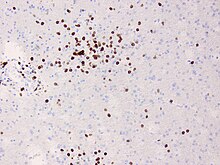Rasmussen syndrome
Rasmussen's encephalitis is a rare inflammatory neurological disease, characterized by frequent and severe seizures, loss of motor skills and speech, hemiparesis (weakness on one side of the body), encephalitis (inflammation of the brain), and dementia. The illness affects a single cerebral hemisphere and generally occurs in children under the age of 15.
Signs and symptoms
The condition mostly affects children, with an average age of 6 years. However, one in ten people with the condition develops it in adulthood.[citation needed]
There are two main stages, sometimes preceded by a 'prodromal stage' of a few months. In the acute stage, lasting four to eight months, the inflammation is active and the symptoms become progressively worse. These include weakness of one side of the body (
In the chronic or residual stage, the inflammation is no longer active, but the affected individual is left with some or all of the symptoms because of the damage that the inflammation has caused. In the long term, most patients are left with some epilepsy, paralysis and cognitive problems, but the severity varies considerably.[1]
Pathophysiology
In Rasmussen's encephalitis, there is
The cause of the inflammation is not known: infection by a
Rasmussen's encephalitis has been recorded with a neurovisceral porphyria, and acute intermittent porphyria.[8]
Diagnosis

The diagnosis may be made on the clinical features alone, along with tests to rule out other possible causes. An
Brain biopsy can provide very strong confirmation of the diagnosis, but this is not always necessary.[9][10]
Treatment
During the acute stage, treatment is aimed at reducing the inflammation. As in other inflammatory diseases,
During the residual stage of the illness when there is no longer active inflammation, treatment is aimed at improving the remaining symptoms. Standard anti-epileptic drugs are usually ineffective in controlling seizures, and it may be necessary to surgically remove or disconnect the affected cerebral hemisphere, in an operation called hemispherectomy or via a corpus callosotomy. This usually results in further weakness, hemianopsia and cognitive problems, but the other side of the brain may be able to take over some of the function, particularly in young children. The operation may not be advisable if the left hemisphere is affected, since this hemisphere contains most of the parts of the brain that control language. However, hemispherectomy is often very effective in reducing seizures.[1][9]
History
It is named for the
Society
The Hemispherectomy Foundation was formed in 2008 to assist families with children who have Rasmussen's encephalitis and other conditions that require hemispherectomy.[15]
The RE Children's Project was founded in 2010 to increase awareness of Rasmussen's encephalitis. Its primary purpose is to support scientific research directed toward finding a cure for this disease.[citation needed]
References
- ^ PMID 15689357.
- PMID 23360283.
- PMID 8036512.
- S2CID 30712041.
- S2CID 19120589.
- S2CID 20681278.
- PMID 27040081.
- S2CID 23773750.
- ^ PMID 24457189.
- PMID 26941743.
- S2CID 32279177. 8208394.
- S2CID 34514886.
- Who Named It?
- PMID 13566382.
- ^ "The Community News". Archived from the original on March 29, 2009. Retrieved 2009-02-25.
External links
- Rasmussen at Public Domainsource.)
